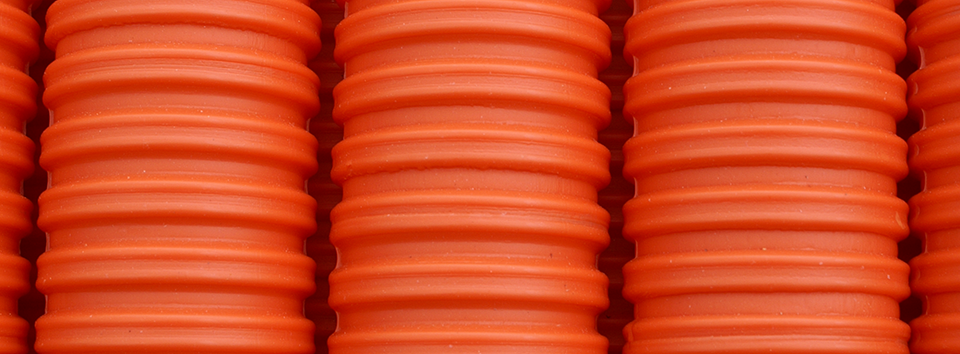Corrugated Conduit

Advantages of Corrugated PE Conduit
- Extruded from HDPE with the same properties described in the Smoothwall Conduit section.
- Corrugated design provides a light weight yet still flexible and strong product.
- The corrugations provide crush resistance in a light weight design.
- The corrugations also reduce the inside surface area of the conduit, reducing friction when pulling fiber.
- Available in 1 1/4" diameter.
- Standard lengths available from 500" coils to 5,000" reels.
- Larger reels, 2, 3, 4-way sectioned reels are available.
- Available in empty, with pull rope or pull tape installed.
Ribbing, or corrugated profiles, results in similar friction reducing geometries. However, there is a tendency for field-added lubrication to be scraped off the cable by the corrugations. In addition, the high degree of flexibility requires careful placement of the duct to reduce the buildup of friction due to path curvature.
Corrugated conduit has properties that generally make it easier to work with in difficult and confined environments. Primarily, this is a result of the lack of memory with corrugated and greater flexibility vs. smooth wall conduit. The lack of memory also provides a corrugated conduit that, when installed as an innerduct (inside of another larger conduit), does not spiral and therefore has lower friction when cables are pulled through it. The greater degree of flexibility makes corrugated conduit easier to handle when used in confined spaces and other restricted environments. Corrugated conduit is not appropriate for use in direct buried applications because of its limited crush resistance and the difficulty of laying it in a straight path.
Corrugated conduit is also not appropriate for use when cables are to be installed using air-assisted placement. Corrugated conduit is relatively thin-walled and may not be able to handle the air pressure of air-assisted placement. The corrugations create air turbulence that is counterproductive to the air-assisted placement systems and significantly reduce the distance cables can be blown through it.
Corrugated conduit should not be installed using directional drilling equipment due to limited tensile strength and the fact that the corrugations will create significant friction during the pullback that will likely cause the conduit to separate. The ASTM standards that cover SIDR and SDR designs do not apply to corrugated duct. Corrugation equipment varies from producer to producer, and inside and outside diameter may vary from each source of supply. All corrugated conduit specifications are per the producer only. Generally a minimum ID is specified and a maximum OD. Corrugated design greatly affects the properties of the conduit such as crush resistance and tensile strength. Tooling used to produce corrugated conduit does not allow the producer to change dimensions without costly retooling.

